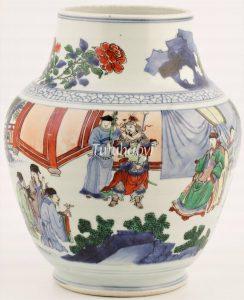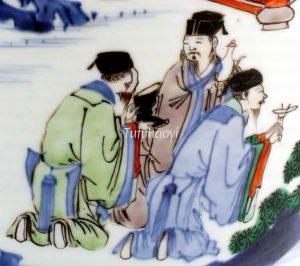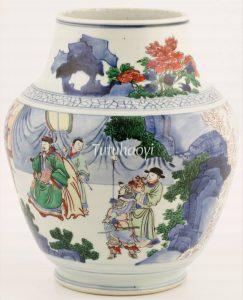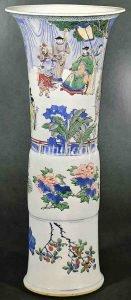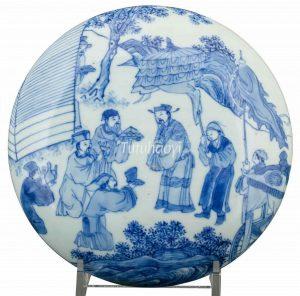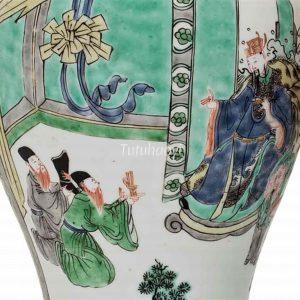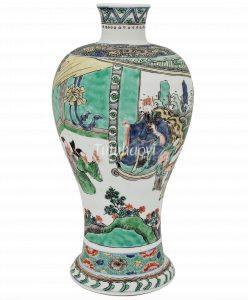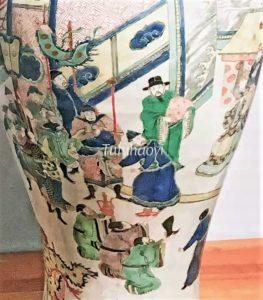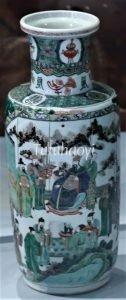The Boot-Swapping Ceremony for the Departing Governor
民赞清官留旧靴
© Tutuhaoyi.com owns the copyright of the description content for the images attached. Quoting all or part of the description content on this page is permitted ONLY IF ‘Tutuhaoyi.com’ is clearly acknowledged anywhere your quote is produced unless stated otherwise. (本页描述内容版权归Tutuhaoyi.com所有,转发或引用需注明 “Tutuhaoyi.com”, 侵权必究, 已注开源信息的条目除外。)
The story scene is originated from an anecdote dating back to the Tang dynasty (618-907). Cui Rong (崔戎, 780-835) is a statesman who is important enough to have a position in the ‘Biographies’ section in the official histories The Old Book of Tang (jiu tang shu 旧唐书), completed in 945, and the New Book of Tang (xin tang shu 新唐书), presented to the then emperor in 1060.
When Cui Rong served as the governor of Hua prefecture, his administrative skills and integrity impressed the locals, dignitaries and farmhands alike. One of his notable deeds was that, on his departure, he made sure that a large sum of money which had been allocated for the customary governor’s personal use was to be disseminated among ordinary soldiers of the local army. After hearing the news that Cui Rong had been assigned to a new post, a large number of people swarmed to the departure ceremony trying to prevent him from leaving. During the chaos, Cui Rong’s boots were accidentally removed by some overenthusiastic members of the crowd and they then kept them as a souvenir.
From then on, when a magistrate departed, a group of local dignitaries would come to him with a gift of a new pair of boots in exchange of the boots he had been wearing. They would display his old boots in a public place to show the locals’ appreciation of his legacy. The tradition endured over a millennium till the last days of the imperial China, as was vignetted in the American missionary Chester Holcombe’s (1842-1912) book The Real Chinaman (1895):
‘When a popular official is about to lay down the seal of office at the conclusion of his term of service, he is waited upon by a deputation of leading residents, who, with many flowery words of compliment and praise, gravely request him to donate to the city a pair of his official boots. The request is esteemed an honour, and is always granted. They are taken in solemn procession, with music and much parade, to the city gate and there suspended, where they remain until they decay and drop to pieces.’
The porcelain vessels adorned with this theme were popular in the early Qing period and were deemed to be an apt gift for departing officials to commemorate their highlights in life.
image identification and literature research by Dr Yibin Ni
Reference:
Jeffrey P. Stamen and Cynthia Volk with Yibin Ni (2017), A Culture Revealed: Kangxi-Era Chinese Porcelain from the Jie Rui Tang Collection 文采卓然:潔蕊堂藏康熙盛世瓷, Jieruitang Publishing, Bruges, pp. 98-99.
Fig 1-4: wucai porcelain pot, Shunzhi period (1644-61), courtesy of the Sir Michael Butler Collection
Fig 5-6: porcelain vase with underglaze blue and overglaze enamelled decoration, Shunzhi period (1644-61), courtesy of the Chang Foundation, Taiwan
Fig 7-8: porcelain covered box with underglaze blue decoration, Kangxi period (1662-1722), courtesy of Jie Rui Tang Collection
Fig 9-10: porcelain bottle vase with overglaze enamelled decoration, dated 1701, courtesy of Jie Rui Tang Collection
Fig 11: porcelain yen yen vase with overglaze enamelled decoration (detail), Kangxi period (1662-1722), courtesy of the Guimet Museum, Paris
Fig 12: porcelain rouleau vase with overglaze enamelled decoration, Kangxi period (1662-1722), courtesy of the Guimet Museum, Paris, photo: Weibo ID @sergio1968
